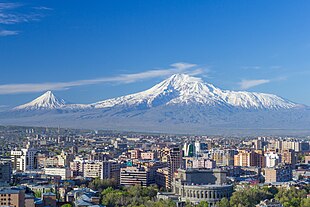Month: August 2017
Arduino – XR-2206 Function Generator
http://www.vwlowen.co.uk/arduino/xr2206/XR2206-function-generator.htm
Ground loop (electricity)
Svalbard
Svalbard (Norwegian pronunciation: [ˈsvɑːlbɑː, ˈsvɑl-];[3] formerly known by its Dutch name Spitsbergen) is a Norwegianarchipelago in the Arctic Ocean. Situated north of mainland Europe, it is about midway between continental Norway and the North Pole. The islands of the group range from 74° to 81° north latitude, and from 10° to 35° east longitude. The largest island is Spitsbergen, followed by Nordaustlandet and Edgeøya.
https://en.m.wikipedia.org/wiki/Svalbard
Mount Ararat
Mount Ararat (/ˈærəˌræt/ ARR-ə-rat;[8] Turkish: Ağrı Dağı; Armenian: Մասիս, Masis and Արարատ, Ararat) is a snow-capped and dormant compound volcano in the extreme east of Turkey.[9] It consists of two major volcanic cones: Greater Ararat, the highest peak in Turkey and the Armenian plateau with an elevation of 5,137 m (16,854 ft); and Little Ararat, with an elevation of 3,896 m (12,782 ft).[10] The Ararat massif is about 40 km (25 mi) in diameter.
Despite the scholarly consensus that the “mountains of Ararat” of the Book of Genesis do not refer to specifically Mt. Ararat, it has been widely accepted in Abrahamic religions as the resting place of Noah’s Ark. It is the principal national symbol of Armenia and has been considered a sacred mountain by Armenians. It is featured prominently in Armenian literature and art and is an icon for Armenian irredentism. Along with Noah’s Ark, it is depicted on the coat of arms of Armenia.
The first efforts to reach Ararat’s summit were made in the Middle Ages. However, it was not until 1829 when Friedrich Parrot and Khachatur Abovian, accompanied by four others, made the first recorded ascent
J. Presper Eckert
John Adam Presper “Pres” Eckert, Jr. (April 9, 1919 – June 3, 1995) was an American electrical engineer and computer pioneer. With John Mauchly he designed the first general-purpose electronic digital computer (ENIAC), presented the first course in computing topics (the Moore School Lectures), founded the Eckert–Mauchly Computer Corporation, and designed the first commercial computer in the U.S., the UNIVAC, which incorporated Eckert’s invention of the mercury delay line memory.
https://en.m.wikipedia.org/wiki/J._Presper_Eckert
John Mauchly
John William Mauchly (August 30, 1907 – January 8, 1980) was an American physicist who, along with J. Presper Eckert, designed ENIAC, the first general purpose electronic digital computer, as well as EDVAC, BINAC and UNIVAC I, the first commercial computer made in the United States.
https://en.m.wikipedia.org/wiki/John_Mauchly
Andromeda Galaxy
The Andromeda Galaxy (/ænˈdrɒmᵻdə/), also known as Messier 31, M31, or NGC 224, is a spiral galaxy approximately 780 kiloparsecs (2.5 million light-years) from Earth.[4] It is the nearest major galaxy to the Milky Way and was often referred to as the Great Andromeda Nebula in older texts. It received its name from the area of the sky in which it appears, the constellation of Andromeda, which was named after the mythological princess Andromeda.
https://en.m.wikipedia.org/wiki/Andromeda_Galaxy
Beehive Cluster
Double Cluster
The Double Cluster (also known as Caldwell 14) is the common name for the open clusters NGC 869 and NGC 884 (often designated h Persei and χ Persei, respectively),[1] which are close together in the constellation Perseus. Both visible with the naked eye, NGC 869 and NGC 884 lie at a distance of 7500 light years.[2] NGC 869 has a mass of 3700 solar masses and NGC 884 weighs in at 2800 solar masses; however, later research has shown both clusters are surrounded with a very extensive halo of stars, with a total mass for the complex of at least 20,000 solar masses.[3] Based on their individual stars, the clusters are relatively young, both 12.8 million years old.[4] In comparison, the Pleiades have an estimated age ranging from 75 million years to 150 million years. There are more than 300 blue-white super-giant stars in each of the clusters. The clusters are also blueshifted, with NGC 869 approaching Earth at a speed of 39 km/s (24 mi/s) and NGC 884 approaching at a similar speed of 38 km/s (24 mi/s).[5] Their hottest main sequence stars are of spectral type B0.
https://en.m.wikipedia.org/wiki/Double_Cluster
Messier 3
Messier 3 (M3 or NGC 5272) is a globular cluster of stars in the northern constellation of Canes Venatici. It was discovered by Charles Messier on May 3, 1764,[8] and resolved into stars by William Herschel around 1784. Since then, it has become one of the best-studied globular clusters. Identification of the cluster’s unusually large variable star population was begun in 1913 by American astronomer Solon Irving Bailey and new variable members continue to be identified up through 2004.
https://en.m.wikipedia.org/wiki/Messier_3
Messier 12
Messier 12 or M 12 (also designated NGC 6218) is a globular cluster in the constellation of Ophiuchus. It was discovered by the French astronomer Charles Messier on May 30, 1764, who described it as a “nebula without stars”.[7] In dark conditions this cluster can be faintly seen with a pair of binoculars. Resolving the stellar components requires a telescope with an aperture of 8 in (20 cm) or greater.[8] In a 10 in (25 cm) scope, the granular core shows a diameter of 3′ (arcminutes) surrounded by a 10′ halo of stars.
https://en.m.wikipedia.org/wiki/Messier_12

